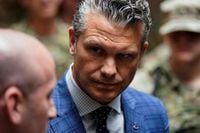Secretary of War Pete Hegseth has set off a firestorm in Washington and beyond after unveiling a sweeping set of reforms for the U.S. military—moves that, supporters say, aim to restore discipline and readiness, but that critics argue threaten the very fabric of diversity and inclusion in the armed forces. Delivered in a 45-minute speech last month at Quantico, Virginia, before nearly every senior officer and enlisted leader in the joint force, Hegseth’s message was clear: the War Department, as it’s now rebranded, is shifting course—and fast.
In a memorandum issued October 6, 2025, and obtained by NPR, Hegseth ordered all War Department personnel to complete the so-called “Warrior Ethos Tasking.” This directive requires every service member to watch the full recording or read the official transcript of Hegseth’s Quantico speech and review the updated policies no later than October 31. “All commanders must document the completion of the Warrior Ethos Tasking in a Memorandum for Record,” the memo states. According to CNN, leaders at every level are on the hook to ensure compliance. The Pentagon, when asked for comment, told NPR, “The Secretary’s speech was for the whole force and this memo just reinforces that guidance.”
Hegseth’s speech itself, delivered in September 2025, was nothing if not bold. He wasted no time declaring, “Good morning, and welcome to the War Department, because the Department of Defense is over.” The rebranding, he explained, is meant to signal a return to a culture focused on winning wars, not just defending against them. “The topic today is about the nature of ourselves; because no plan, no program, no reform [and] no formation will ultimately succeed unless we have the right people and the right culture at the Department of War,” Hegseth told the assembled leaders, as reported by official War Department communications.
Among the ten new directives Hegseth announced, several stand out for their sweeping impact. Fitness standards, for example, have been overhauled: active component service members from all branches must now complete two annual fitness tests, with one specifically tailored to combat roles. “It all starts with physical fitness and appearance. If the secretary of war can do regular, hard PT, so can every member of our joint force,” Hegseth said, as quoted in the War Department’s official summary. For those in combat-related occupations, the bar is set at a “gender-neutral male standard” with a minimum score of 70%. Daily physical training is now mandatory for active-duty members, while National Guard and reserve troops must take at least one fitness test a year.
Grooming standards are also getting a facelift—literally. Beards, long a topic of debate across the services, are now banned. Service members with medical exemptions have a year to seek treatment for their condition, after which the expectation is clear: “Simply put, if you do not meet the male-level, physical standards for combat positions, cannot pass a PT test or don’t want to shave and look professional, it’s time for a new position or a new profession,” Hegseth said.
But for many, the most controversial changes go beyond physical standards. Hegseth’s speech and subsequent policies have drawn fierce criticism from advocacy groups and former military leaders alike, particularly regarding their impact on women and minorities in the armed forces. The National Women’s Law Center (NWLC), in a detailed analysis published October 17, 2025, accused Hegseth of “showcasing his regressive views on women in the military.” According to the NWLC, Hegseth’s remarks suggested women are too weak to serve and called for all service members to meet the “highest male standard”—a move the Center says is not truly gender neutral and ignores strengths women bring to the force, such as endurance and resilience.
“I’m straight up saying we should not have women in combat roles,” Hegseth has previously stated, according to the NWLC’s report. Critics argue that such rhetoric undermines recruitment and retention, and ultimately threatens national security. The NWLC further points out that, since 1993, it has been illegal to alter occupational performance standards simply to increase or decrease the number of women in the military. “Hegseth is the one inserting gender into the standards, with his bizarre insistence that everyone meet the ‘highest male standard,’” the NWLC stated.
The reforms don’t stop at fitness. Hegseth’s speech included pointed attacks on the systems designed to prevent and address sexual harassment and assault. The NWLC highlighted that Hegseth has signaled his intent to eliminate anonymous complaints and to dismiss complaints lacking “actionable credible evidence” without first allowing for the development of such evidence. Critics warn these changes will have a chilling effect on victims, many of whom already fear retaliation for coming forward. The NWLC notes that Hegseth himself has been “credibly accused of sexual assault and has faced IG review over his use of Signal to discuss sensitive military operations.”
Access to reproductive health care is another flashpoint. In January 2025, Hegseth rescinded a policy that had allowed service members and dependents to travel for abortion care, a move that, according to the NWLC, “will harm service members and dependents who are denied abortion care in the military, exacerbating the current reproductive health care crisis.” Federal law already restricts military abortion services to cases of rape, incest, or life endangerment, and with many bases located in states with abortion bans, the rescinded policy had been a crucial lifeline for some military families.
Institutional support for women has also taken a hit. In September 2025, the Defense Advisory Committee on Women in the Services (DACOWITS) was eliminated. This committee, which had provided advice on recruitment, retention, and well-being of servicewomen, was accused by the new administration of “advancing a divisive feminist agenda.” Its recommendations, critics say, benefited all service members, not just women.
Perhaps most symbolic of the new direction was the ousting of Adm. Lisa Franchetti, the first woman to lead the Navy and serve on the Joint Chiefs of Staff. Her firing, which came with little explanation, follows a pattern, critics argue, of removing women from top leadership posts in favor of a more “traditional” military hierarchy. The NWLC notes this move came after President Trump’s earlier firing of Adm. Linda Fagan, the first woman to lead a branch of the armed forces as commander of the Coast Guard.
Hegseth, for his part, frames all these changes as part of a necessary cultural shift. “We’re ending the war on warriors,” he declared in his Quantico address. He insists that the military had been forced to focus on the wrong things by “foolish and reckless politicians,” and that his mission is to “fix decades of decay” and remove distractions from the military’s core purpose. “Standards must be uniform, gender-neutral and high. If not, they aren’t standards, they’re just suggestions,” he said, emphasizing a vision of merit-based promotion and real-world training over “PowerPoint reviewer online courses.”
As the October 31 deadline for the Warrior Ethos Tasking approaches, the debate over Hegseth’s reforms is only intensifying. Supporters argue that the changes will restore discipline and readiness, while critics warn they risk rolling back decades of progress on equality and inclusion. The only certainty, it seems, is that the U.S. military stands at a crossroads—one where the choices made today will shape its culture, effectiveness, and identity for years to come.




